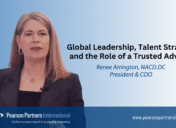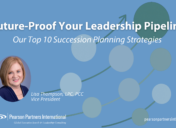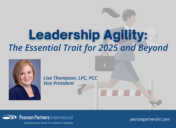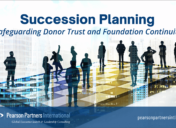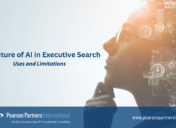The Business of NIL: Five All-Stars on the Changing World of College Athletics
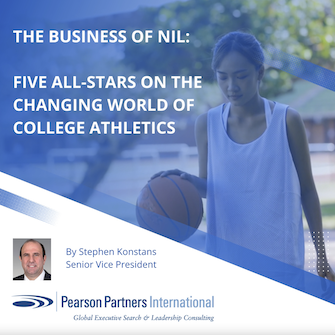
Pearson Partners Spotlight Series™ Breakfast Q3 2022
By Stephen P. Konstans
Former Senior Vice President
For over a century, student-athletes were not allowed to make money from their name, image or likeness (NIL) through sponsorship deals. Last year, those regulations unraveled thanks to a historic 9-0 Supreme Court ruling. Now that student-athletes are over a year into owning their NIL rights, we spoke with five all-stars to hear the latest developments in the business of college athletics.
A brief history of NIL in college athletics
Amateurism has been central to the National Collegiate Athletic Association’s (NCAA) regulatory approach since its inception, including forbidding students to make money from their name, image or likeness (NIL). However, as college sports grew into a multi-billion-dollar industry, this tenet was increasingly questioned: Why should the athletes at the heart of the industry not benefit from their skill and dedication?
On June 21, 2021, this all changed.
The Supreme Court delivered a rare 9-0 ruling against the NCAA that meant it could no longer limit education benefits offered to student-athletes by academic institutions. The accompanying opinion of the court indicated that compensation restrictions imposed by the NCAA would not hold up against antitrust laws.
The NCAA launched new rules on July 1, 2021, allowing schools to set their own NIL policies. As of July 2022, student-athletes had earned an estimated $970 million from NIL deals.
The winds of change continue to build velocity.
To learn more about how NIL law is changing the world of college sports, Pearson Partners did what we do best: We “headhunted” industry-leading talent for an all-star panel at our recent Spotlight Series™ breakfast at the Park City Club in Dallas.
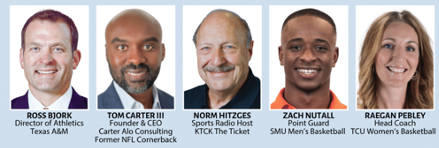
- Ross Bjork, Director of Athletics, Texas A&M
- Tom Carter III, Founder & CEO, Carter Alo Consulting, and Former NFL Cornerback
- Norm Hitzges, Sports Radio Host, KTCK The Ticket
- Zach Nutall, Point Guard, SMU Men’s Basketball
- Raegan Pebley, Head Coach, TCU Women’s Basketball
From purpose-driven leadership to what matters in recruitment, our panelists shared fascinating insights along with valuable lessons on how leaders steer their teams through change.
Navigate uncertainty with purpose-driven leadership.
We heard across the panel that there is a vacuum of governance in this major transformation of college athletics. No one said it more plainly than Norm Hitzges, Sports Radio Host on KTCK The Ticket: “The NCAA does not lead college sports anymore. In fact, I think college sports are leaving the NCAA behind. We’ve got a rudderless ship right now.”
While the NCAA had been leading in setting and enforcing regulations, the Supreme Court ruling directly called that into question. Who fills that space now? No one knows yet. But with every challenge, there is opportunity.
Ross Bjork, Director of Athletics at Texas A&M, shared his purpose-driven approach: “We have to step up as universities and conferences to solve this,” said Bjork. “We always end our staff meetings at Texas A&M saying the only reason we’re here is these young athletes. It’s worth every single student-athlete and every single opportunity. Many positives will come out of this moving forward.”
Raegan Pebley, Head Coach of TCU Women’s Basketball, shared Bjork’s positive outlook: “The reason I do this job is to empower these women. With NIL, I’d love to add an E at the end: Name, Image, Likeness and Empowerment. Opportunities for them to grow into the amazing people they are.”
We live in a time of economic and geopolitical instability. Like coaches and athletic directors, business leaders must ask themselves, how is my team affected by the external environment? As a leader, how can I be a rock to our people? And how do I lead by serving others?
Clearly defining your North Star, as Bjork and Pebley have done, will ensure you reach your full potential for positive impact.
Go all-out to stay competitive.
Following your purpose isn’t easy. It can sometimes mean taking the fight to the highest levels of courts or governments. In college athletics, this is where the role of collectives and the state laws that govern them come in.
Collectives are independent organizations often created by alumni groups and superfans designed to support student-athletes financially. Most of these collectives are not affiliated by law or governance with their universities, yet they can influence recruitment.
Bjork shared his experience with collectives that might seem bewildering to an outsider: The collective is an external organization paying the athletes, but the coach has no input. “Let’s take our game against Appalachian State,” Bjork explained. “North Carolina state law allows them to form a collective as a university, whereas Texas state law does not allow our university or the athletic department to be involved. We’re at arm’s length and have no control over who they’re paying or how.”
The high variability of laws and maturity of collectives among states adds to criticism of an unequal and confusing playing field. However, these restrictions can be changed through the proper channels, such as the July 2021 NCAA NIL regulation.
A recent example of such criticism was when Louisana Rep. John Stefanski (R) implored state legislators earlier this summer to pass amendments on NIL and collectives so LSU could compete (in recruitment) with other schools. Legislators agreed with his arguments and changed the law.
Successful business leaders advocate for laws that support their organization’s competitiveness and provide favorable conditions for their people. If there are unfair restrictions—especially those violating antitrust laws—they go to bat for their team.
Attract top talent with more than just money.
For many athletes, recruitment is not all about the money. Many factors weigh on their decisions aside from compensation.
John Ruiz, Founder & CEO of LifeWallet and a University of Miami booster, recently drew widespread speculation of a pay-for-play recruiting inducement after signing a $9.5 million NIL agreement with Jaden Rashada, now quarterback for the Miami Hurricanes.
However, Ruiz shared with The Washington Post that all of his deals went through the compliance office and represented standard marketing agreements. Weeks later, Michael W. Caspino, the NIL lawyer representing Rashada, reported to On3 that the 4-star player took a “considerably lesser NIL deal” by picking the Hurricanes. “Jaden left millions on the table,” said Caspino. “Millions. He did not pick the highest offer. He went there because he loves Miami, the coaches, and the opportunity.”
Zach Nutall, SMU Men’s Basketball Point Guard, shared a similar sentiment: “Being a competitor, my main goal has always been to fulfill my role as an athlete. I can’t speak for every team in America, but SMU is focused on winning basketball games. You know, growing in family and growing in tradition.” While money has come into play with NIL, Nutall explained that his primary drive will always be to compete and to seek team environments where he can excel.
Compensation in college athletics may evolve the same way as in the NFL over the last 40 years and become tied to performance, position and playtime. Of course, there is still a long way to go with NCAA rules restricting direct pay-for-play packages. With NIL law so new, much is yet to be seen.
In recruitment, it is essential to communicate your value proposition clearly and personalize your pitch around individual motivators. Often, you need to get creative with compensation expectations, especially in highly competitive environments.
For organizations, structuring a creative offer might include remote work, performance-based pay, sign-on bonuses or shorter pay review periods. The counsel of an experienced search firm can be invaluable in the pivotal offer and negotiation phase of recruiting top talent.
Understand the importance of great representation.
Rashada’s incredible compensation and reportedly strong match with the Miami Hurricanes show how vital great representation is in college athletics.
Tom Carter, Founder & CEO of Carter Alo Consulting, said he “doesn’t take a penny from the athletes.” His deep commitment to students stems from his own experiences as a student-athlete and knowing just how important it is to have someone in your corner. “I just want to make sure that they go to a place with integrity and with coaches that they trust and care for,” said Carter.
Great representation is essential for career development in every industry. Organizations and executives alike should move beyond a transactional approach with recruiters and instead focus on building long-term partnerships. Recruiters provide representation to both sides, which can truly transform businesses and careers.
Align values and culture for high-performing teams.
Athletics leaders place as much importance on values alignment as recruits do. In recent years, they can leverage an expanding array of assessment and evaluation tools to look beyond standard metrics toward coachability, values and development potential.
Pebley noted that coaches play a leading role in crafting cohesive teams: “It’s not going to change for us that we’re recruiting culture fits. We’re recruiting people who have values that align with ours and who make decisions based on those values.”
Getting assessment right can be the difference between high-performing teams that can ride highs and lows and those that crumble under pressure or adversity.
Create conditions that support retention.
With the income generated through NIL deals, student-athletes now have a path to earn while completing their education. Previously, many would have to leave school early for professional sports as the only way to generate income.
NIL rules will thus have a tremendous effect on retention. However, while enjoying a retention boost, colleges must navigate another recent and impactful development: Students are now allowed to transfer immediately rather than sitting out a year.
Hitzges touched on this development when discussing the sweeping changes facing college athletes: “Realignment, NIL and the transfer portal would all have been enormously impactful on college athletes had just one of them happened. All three are happening at once.”
With more offers on the table, expanding and more competitive leagues and the freedom and infrastructure for athletes to move quickly, it is more important than ever for recruiters to nurture relationships with athletes.
Business leaders are facing similarly intense competition for talent. Leaders must ask themselves if they are genuinely offering employees a path to stay, with market-matching packages and flexible working policies, or if they are leaving the door wide open.
Empower teams with learning and development.
Learning and development programs are crucial in empowering student-athletes with the tools and knowledge to manage their lives and build their futures. Fortunately, colleges have invested extensively in L&D. These programs will need to continue developing and expanding to meet the new challenges NIL brings.
Pebley shared, “I’m going to pat TCU’s back on what they’re doing through the Neely School of Business, educating and empowering these student-athletes and providing them with financial literacy and mental health support.”
Bjork added, “Texas state law requires that all schools have education programs for student-athletes. We also partner with our business school to provide robust education and monitoring.”
At its base level, L&D creates space for conversation and knowledge transfer. Though components like personal finance may be outside the scope of traditional L&D programs, developing more balanced and secure people leads to improved long-term performance.
The pandemic severely curtailed many in-person aspects of L&D programs, such as coaching, work-shadowing and peer-to-peer connection. Now is the time for business leaders to take stock and bring the focus back to fostering relationships and supporting career development, especially for younger employees.
Foster programs to balance work, life and study.
While business employees often discuss challenges with work-life balance, college students face a third component: study. Now the college athlete—already juggling an entire academic program, a 40–50 hour training plan and regular travel for games—has the added financial complexity of managing NIL deals. This pressure can be tremendous for a young adult.
Nutall described balancing the pressure of managing NIL deals with its rewards: “Having money coming into play has made it harder. You have these new assignments and expectations. But this opportunity is a blessing, and it propels you toward what you really desire. Nothing is worth having if it’s not hard.”
Monitoring is a crucial ally to L&D programs. By ensuring any signs of trouble surface early, leaders can respond with targeted resources.
But let’s not lose sight of the opportunities NIL deals provide. As Nutall shared, “It’s really been a pleasure and an honor to receive this money. It’s allowed me to get a headstart on my life.”
L&D resources are plentiful in many organizations, but the time allocated to make the most of them is often woefully lacking. Business leaders must create space for education in the workplace rather than expecting it all to occur outside of working hours. Further, we must rethink L&D job requirements and ensure barriers to entry do not discourage diverse, talented people from pursuing these roles.
Support international talent with specialized programs.
While domestic talent is free to pursue NIL deals, Pebley shared that international athletes face much more difficulty. “International students are here on F-1 visas, which don’t allow you to work off-campus. It’s challenging because the laws don’t allow them to make NIL money as easily. You can do stuff in your home country and earn passive income. But it is challenging.”
Over the last year, many top international performers have had to sit on the NIL bench or pursue much smaller agreements through complex loopholes while their domestic teammates benefit from lucrative deals. Meanwhile, the prospect of their visa revocation means the stakes could not be higher.
However, there is hope on the horizon. Bjork shared that there are conversations in Congress to update NIL laws for international students. In the meantime, it is yet another area of uncertainty for our athletes, and international students certainly need extra support.
More broadly, most work visas have restrictions that add complexity to the lives of expat workers—people who often support family from afar and struggle to maintain a sense of permanence with limited-time visas. Business leaders can offer support to international employees in many ways, including creating peer groups, developing feedback channels to respond to needs, clearly communicating career and permanent residence paths and helping with legal advocacy.
Carefully monitor diversity, equity and inclusion.
While women are thriving in the NIL space, collectives are far more weighted toward men. If collectives become directly affiliated with institutions in the future, this imbalance could compromise equality legislation.
“Female athletes are some of the leaders in the name, image and likeness space. They are not in the collectives space,” shared Pebley. “And if collectives are going to be run through institutions, you now have an issue with Title IX. It’s important to have that conversation.”
With more money flowing into college athletics, universities—like businesses—must keep a keen eye on diversity, equity and inclusion.
Are you doing enough in your business to ensure equal pay and opportunity? We are still on the path to gender equality in the workplace and must continually find ways to advance diverse and inclusive teams.
Be empathetic to your people.
At the heart of the fast-evolving and highly unstructured NIL environment are young adults under significant pressure. With every sensationalist headline comes additional weight on their shoulders. Describing his experience in the NFL draft, Carter said, “The next day in the paper, I was named St. Petersburg’s newest millionaire. I almost crumbled.”
Of course, with challenge comes opportunity. As leaders and mentors, we must unite to provide a safe harbor for student-athletes, allowing them to be the best versions of themselves—as we must for young people across all industries.
Let’s continue to shed light on hidden topics, pass along our wisdom and create space for personal and career development. After all, students and career starters are our future. Knowing we have purpose-driven leaders like our panelists dedicated to shaping this future gives us great confidence and excitement for the path ahead.

